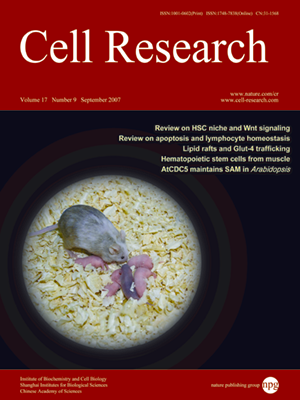
Volume 17, No 9, Sep 2007
ISSN: 1001-0602
EISSN: 1748-7838 2018
impact factor 17.848*
(Clarivate Analytics, 2019)
Volume 17 Issue 9, September 2007: 792-803
ORIGINAL ARTICLES
Activation of paternally expressed imprinted genes in newly derived germline-competent mouse parthenogenetic embryonic stem cell lines
Hua Jiang1,2,3, Bowen Sun1,2, Weicheng Wang1,2, Zhihong Zhang1, Furong Gao1,2,3, Guilai Shi1,2,3, Bing Cui1, Xiangyin Kong1, Zhao He4, Xiaoyan Ding4, Ying Kuang5, Jian Fei5, Yi Juan Sun6, Yun Feng6 and Ying Jin1,2
1The Key Laboratory of Stem Cell Biology, Institute of Health Sciences, Shanghai Institutes for Biological Sciences, Chinese Academy of Sciences/Shanghai JiaoTong University School of Medicine, 225 South Chongqing Rd, Shanghai 200025, China
2Shanghai Institute of Stem Cell Research, Shanghai JiaoTong University School of Medicine, 280 South Chongqing Rd, Shanghai 200025, China
3Graduate School of Chinese Academy of Sciences, Beijing, China;
4Institute of Biochemical and Cellular Biology, Shanghai Institutes for Biological Sciences, Chinese Academy of Sciences, 320 Yueyang Rd, Shanghai 200031, China
5Shanghai Research Center for Model Organisms, 88 Cai Lun Road, Shanghai 201203, China
6Reproductive Medical Center, Ruijin Hospital, 197 Second Ruijin Rd, Shanghai 20135, China
Correspondence: Yun Feng Ying Jin(artruijin@yahoo.com.cn yjin@sibs.ac.cn)
Parthenogenetic embryonic stem (pES) cells provide a valuable in vitro model system for studying the molecular mechanisms that underlie genomic imprinting. However, the pluripotency of pES cells and the expression profiles of paternally expressed imprinted genes have not been fully explored. In this study, three mouse pES cell lines were established and the differentiation potential of these cells in extended culture was evaluated. The undifferentiated cells had a normal karyotype and homozygous genome, and expressed ES-cell-specific molecular markers. The cells remained undifferentiated after more than 50 passages and exhibited pluripotent differentiation capacity. All three lines of the established ES cells produced teratomas; two lines of ES cells produced chimeras and germline transmission. Furthermore, activation of the paternally expressed imprinted genes Snrpn, U2af1-rs1, Peg3, Impact, Zfp127, Dlk1 and Mest in these cells was detected. Some paternally expressed imprinted genes were found to be expressed in the blastocyst stage of parthenogenetically activated embryos in vitro and their expression level increased with extended pES cell culture. Furthermore, our data show that the activation of these paternally expressed imprinted genes in pES cells was associated with a change in the methylation of the related differentially methylated regions. These findings provide direct evidence for the pluripotency of pES cells and demonstrate the association between the DNA methylation pattern and the activation of paternally expressed imprinted genes in pES cells. Thus, the established ES cell lines provide a valuable model for studying epigenetic regulation in mammalian development.
Cell Research (2007) 17:792-803. doi: 10.1038/cr.2007.70; published online 4 September 2007
FULL TEXT | PDF
Browse 2088


